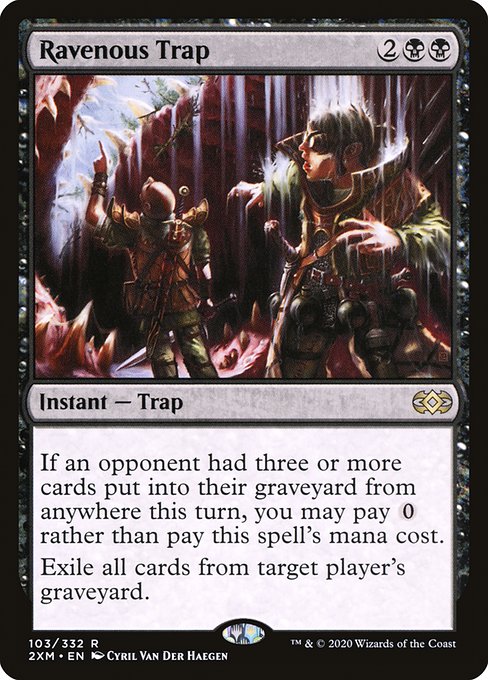
Top Performing Decklists
| Deck | Creator | Record | Best Finish |
|---|---|---|---|
| Izzet Prowess | riku kumagai | 9-3 | None |
Performance Stats (Last 14 Days)
Win Rate Impact
Top Table Win Rate
Meta Trend
Sample Size
Tournament Results
Average Copies
Archetypes Using This Card:
Azorius Omniscience , Dimir Midrange , Domain Zur Overlords , Esper Pixie , Izzet Prowess , Jeskai Control , Jeskai Omniscience
Meta Performance Analysis
Ravenous Trap ranks #4005 out of approximately 5129 cards in raw efficiency (top 78%).
Game Impact Factor
Color Differential
Black average: 49.9%
Performance compared to other Black cardsBased on our comprehensive multi-metric analysis, Ravenous Trap is an underperforming card in the current meta.
Recommended number of copies: 1
Win Rate Timeline
Card Efficiency Analysis
Raw Efficiency (Win Rate/Mana)
Relative Efficiency
Performance Efficiency: 1.36 (Win rate × Top 8 rate ÷ Mana value)
At 4 mana, the average win rate in the format is 47.9%. Ravenous Trap has a win rate of 54.4%, making it 13.6% better than other 4-mana cards.
Top Performing Partners
| Card Name | Type | Deck Count | Win Rate | 1st Places |
|---|
Card Synergy Analysis
Cards that perform better with Ravenous Trap than they do on average. A positive synergy score indicates stronger performance together.
| Card Name | Type | Mana | Decks | Win Rate Together | Win Rate Apart | Synergy Score |
|---|---|---|---|---|---|---|
| Narset, Parter of Veils | Legendary Planeswalker — Narset | 3 | 6 | 63.2% | 55.4% | +7.8% |
| Force of Negation | Instant | 3 | 5 | 61.8% | 55.3% | +6.5% |
| Dig Through Time | Instant | 8 | 8 | 59.6% | 54.3% | +5.3% |
| Treasure Cruise | Sorcery | 8 | 6 | 60.5% | 56.1% | +4.4% |
| Mox Ruby | Artifact | 0 | 8 | 59.6% | 55.5% | +4.1% |
| Preordain | Sorcery | 1 | 8 | 59.6% | 55.7% | +3.9% |
| Gitaxian Probe | Sorcery | 1 | 7 | 60.0% | 56.4% | +3.6% |
| Ponder | Sorcery | 1 | 9 | 58.5% | 55.0% | +3.5% |
| Flusterstorm | Instant | 1 | 6 | 58.2% | 54.8% | +3.4% |
| Black Lotus | Artifact | 0 | 9 | 58.5% | 55.1% | +3.3% |
Top Archetypes
| Archetype | Deck Count | % of Archetype | Win Rate |
|---|---|---|---|
| Esper Pixie | 3 | 0.2% | 45.8% |
| Azorius Omniscience | 2 | 0.3% | 20.0% |
| Jeskai Control | 2 | 0.6% | 50.0% |
| Izzet Prowess | 2 | 0.2% | 75.0% |
| 1 | 1.6% | 0.0% |
Statistics Explanation
| Statistic | Description | Formula |
|---|---|---|
| Win Rate Impact | How much this card increases or decreases the win rate of decks that include it, compared to the average deck in the format. | (Win rate of decks with this card) - (Average win rate of all decks) |
| Top Table Win Rate | A weighted win rate that gives more significance to performance in higher tournament placements. First place finishes count for 2x, with diminishing weight down to 8th place. | ∑(wins × placement_weight) / ∑((wins + losses) × placement_weight) |
| Meta Trend | Shows if the card is performing better or worse in the most recent period compared to earlier periods. Positive values indicate improving performance. | (Win rate in recent half of time period) - (Win rate in earlier half of time period) |
| Confidence Factor | A measure of statistical reliability based on sample size. The progress bar indicates how confident we are in the statistics (with larger sample sizes providing higher confidence). | log10(Number of decks + 1) |
| Average Copies | The average number of copies of this card included in decks that use it. | ∑(Copies in each deck) / (Number of decks) |
| Card Synergy Score | Measures how well this card performs with other cards compared to their individual performance. | (Win rate together) - (Average of individual win rates) |
| Raw Efficiency | Win rate points per mana invested. Higher values indicate better returns on mana investment. | (Win rate) / (Mana value) |
| Relative Efficiency | How efficient this card is compared to the average card of the same mana value. | ((Win rate) / (Format average win rate for same mana)) / (Mana value) |
| Performance Efficiency | Combined metric that accounts for win rate, tournament success, and mana investment. | (Win rate × Top 8 placement rate) / (Mana value) |
| Game Impact Factor | A measure of how much this card affects game outcomes, based on win rate adjusted by its deviation from the format average. | Win rate × (1 + (Win rate - Format average) / 100) |
| Color Differential | How this card's win rate compares to the average win rate of other cards of the same color. | Win rate - Average win rate for same color |
All statistics are calculated using tournament data from the selected time period. Sample sizes below 10 decks may not provide statistically significant results.